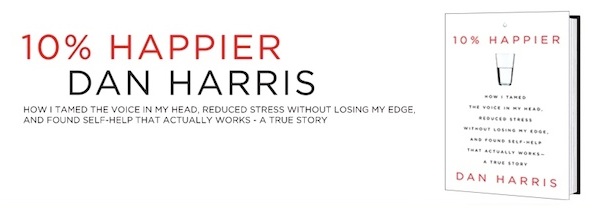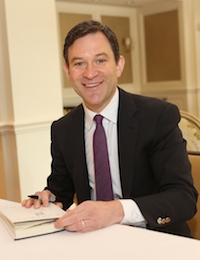Meditation For Cancer Survivors: Getting Started
Editor’s Note: For the first time, researchers have shown that practicing mindfulness meditation has a positive physical impact at the cellular level in breast cancer survivors. For many years, oncologists have known that alternative or integrative therapies likes meditation bolster the emotional well-being of cancer survivors. ABC News anchor Dan Harris, a leading and studied proponent of meditation, in late 2014 shared his own research at a CancerForward forum. Harris’ best-selling book, “10% Happier” is based on that research and Harris’ personal experience.
 The first thing to know about meditation is that it need not be complicated or time consuming.
The first thing to know about meditation is that it need not be complicated or time consuming.
 The first thing to know about meditation is that it need not be complicated or time consuming.
The first thing to know about meditation is that it need not be complicated or time consuming.
 You don’t need to join a group, learn Sanskrit, or wear special outfits. And just five to ten minutes a day is a good start. (I don’t care how busy you are—even if you’ve got three jobs and seventeen children, you can definitely carve out five to ten minutes a day.)
You don’t need to join a group, learn Sanskrit, or wear special outfits. And just five to ten minutes a day is a good start. (I don’t care how busy you are—even if you’ve got three jobs and seventeen children, you can definitely carve out five to ten minutes a day.)
Below are the beginning instructions. All you really need to do in order to get started is read these three simple steps and let rip. That’s basically what I did when I first got interested in meditation; I read a book or two and went for it. It was only after many months that I started occasionally going to a class or working with a teacher. However, if you want an app or a class—or even, for the especially gung-ho, a silent retreat —I’ve added a bunch of links at the bottom.
Basic mindfulness meditation instructions
- Sit comfortably. You don’t have to twist yourself into a cross-legged position—unless you want to, of course. You can just sit in a chair. (You can also stand up or lie down, although the latter can sometimes result in an unintentional nap.) Whatever your position, you should keep your spine straight, but don’t strain.
- Feel your breath. Pick a spot: nose, belly, or chest. Really try to feel the in-breath and then the out-breath.
- This last step is the key: Every time you get lost in thought—which you will, thousands of times—gently return to the breath. I cannot stress strongly enough that starting over (and over… and over…) is the whole game. As my friend and meditation teacher Sharon Salzberg has written, “Beginning again and again is the actual practice, not a problem to overcome so that one day we can come to the ‘real’ meditation.”
Pro tips
- To stay focused on the breath, try making a soft mental note, like “in” and “out.” (Don’t get too mesmerized by the note itself, just use it to direct your attention to the actual sensory experience of the breath.)
- “Noting,” as it’s called, can also be useful when something strong—such as itches, pain, worries, or hunger—comes along and drags your attention away from the breath. The act of applying a label—“planning,” “throbbing,” “fantasizing”—can objectify whatever’s going on, making it much less concrete and monolithic. (Don’t get too caught up in thumbing through your internal thesaurus for the right word. Make a note and move on.)
- Another trick for staying focused is to count your breaths. Start at one, and every time you get lost, start over. When you reach ten—if you ever reach ten—start back at one.
- Try to meditate every day. Regularity is more important than duration.
- Set a timer so that you don’t have to check your watch. There are apps for this. (I use something called the Insight Timer)
- Beginning meditators are sometimes advised to sit at the same time and in the same place every day. If, like me, your schedule is unpredictable and involves a lot of travel, don’t worry about it. I sit whenever and wherever I can fit it in.
- Every once in a while, do a little reading about meditation or Buddhism. Even though the basic instructions are simple, hearing them repeatedly can be useful. It’s the opposite of airplane safety announcements. Also, since the practice itself often feels stupid (“in,” “out,” ad nauseam), glancing at even a few passages of a good book can be a helpful reminder of the intellectual underpinnings of the practice, which are extremely compelling. Here are some books I like:
Real Happiness, Sharon Salzberg
Insight Meditation, Joseph Goldstein
Going to Pieces Without Falling Apart, Dr. Mark Epstein
Buddhism Without Beliefs, Stephen Batchelor
Some useful context
The word meditation, it has been said, is kind of like the word “sports.” It describes a whole range of activities. (E.g.: water polo and badminton don’t have much in common.) When I talk about meditation, I’m talking about either “mindfulness” or “insight” meditation. And so you know, there are some key differences between these two:
Mindfulness meditation is completely secular, and is usually taught through a program called Mindfulness Based Stress Reduction, or MBSR. It was developed by a former MIT molecular biologist named Jon Kabat-Zinn. (His books are totally worth reading. You can find them here. Essentially what Jon has done is to take Buddhist meditation, strip out all the jargon and the metaphysics, and rebrand it as a sort of brain exercise that anyone can do.
Insight meditation (also known as Vipassana) is firmly and unabashedly Buddhist. It is what MBSR is based on. Before you get scared and start thinking you’re going to be pulled into some sort of weird cult, it’s worth noting that Buddhism is not a religion in the usual sense. There is no God or creation myth in Buddhism. In fact, the Buddha himself—while he did talk about things like karma, rebirth, and enlightenment—explicitly told his followers that they could take or leave his metaphysical claims. Even though I am a devout agnostic, I have no problem practicing Buddhism. (Many people of faith are cool with it, too. For example: Without Buddha I Could Not Be a Christian. As the writer Stephen Batchelor has said, Buddhism is “not something to believe in, but something to do.”
 (For the record, I am in favor of pretty much all forms of meditation. Within Buddhism, there are many flavors – including Zen and several forms of Tibetan meditation. There is also Hindu, or Vedic, meditation, which has been around for millennia and remains quite popular. And finally, Christians, Jews, and Muslims all have their own forms of meditation. I encourage you to do some research, and find whatever works for you. Personally, I happened to gravitate toward mindfulness because it is the kind that has been the focus of much of the scientific research.)
(For the record, I am in favor of pretty much all forms of meditation. Within Buddhism, there are many flavors – including Zen and several forms of Tibetan meditation. There is also Hindu, or Vedic, meditation, which has been around for millennia and remains quite popular. And finally, Christians, Jews, and Muslims all have their own forms of meditation. I encourage you to do some research, and find whatever works for you. Personally, I happened to gravitate toward mindfulness because it is the kind that has been the focus of much of the scientific research.)
Free online guided meditations
Here’s a sampling from the Insight Meditation Society, where I often go to study.
Some offerings from UCLA, which has an excellent center for the study and teaching of mindfulness.
An app I recommend
Headspace is legit. I know the guys who run it. It’ll cost you a little something – but it’s not exorbitant.
An online MBSR class
This, too, will cost you a little money, but it’s the foundational eight-week course for secular mindfulness.
Physical centers where you can study
This is a nice little guide to various centers around the U.S. from my friends at Mindful Magazine.
They left a few places off the list, so I will supplement with these:
In New York
Cambridge
Finding a teacher
If you go to any of the centers above, you can find plenty of teachers. If you live in a remote area, you can also do some googling and find someone who teaches over Skype. In terms of what to look for from a teacher, here’s a brief, useful primer from Mindful Magazine.
The information found here is not intended to provide nor should it be interpreted to provide professional medical, legal or financial advice. You should consult a trained professional for more information.
Category: Experts Speak
Tags: 10% Happier, ABC News, Buddhism, cancer, cancer survivor, CancerForward, Dan Harris, Feel your breath, Headspace, Hindu, Houston, Insight meditation, Insight Meditation Society, Insight Timer, Jon Kabat-Zinn, MBSR, Mindful Magazine, Mindfulness Based Stress Reduction, mindfulness meditation, secular mindfulness, Stephen Batchelor, Tibetan meditation, UCLA, Vedic, Zen
